Well, here we are. We stand at what is typically the halfway point in my deck construction habits. Or, as it’s most commonly known, the problematic period.
See, I have an admiration for lists. There’s just something rewarding about compiling a list and going about accomplishing those tasks in some order. Whether it’s making a grocery list, tracking all of my various work/house/site projects, or simply jotting down ideas for Magic decks, the act of putting together such things is enjoyable on some base level.
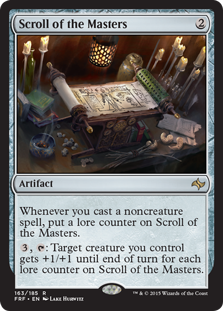
Now where did I leave my pen…
However, lists and I also run into two distinct relationship problems. That is, I have a tendency to forget about them once they’re made, either in the physical sense (meaning I’ve gone and lost it), or I don’t actually cross things off from them until well after said projects and tasks get accomplished. Groceries still get bought, bills still get paid, and work still gets done, but I neglect crossing those feats off after the fact. Unfortunately, this routinely leaves my lists in a sad state of existence, as the whole purpose of a list’s being, its sole purpose, is to have their items completed and crossed off as you go. They’re far less useful in the long run if you start off working off a list only to have the entire thing be moot the next chance you look at it.
Project management, it’s not my strong suit.
The same applies to Magic construction. Although I’ve stated multiple times that building a deck isn’t my most enjoyable facet of the game, I do intrinsically enjoy the act of putting the component lists together that eventually get combined to become decks. I relish the idea of digging through cards or searching on Gatherer, looking for ones to fit a particular mechanic, style, or oddball goal. I, for example, have fun trying to find uses for cards that seemingly don’t have widespread use.
Much like misplacing the grocery list, though, few of these Magic search lists end up being fully implemented for one reason or another. Sometimes I simply turn my attention elsewhere and lose focus. Other times the various mechanics, combos, or themes prove to be too difficult to do, or they get put on the back burner until I finish with whatever Magic-y thing I’m currently working on so long that they gather mothballs.
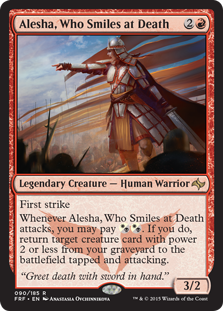
She waits for neither scholar nor bureaucrat
In true procrastination fashion, this is where we find ourselves today. In my mind, the first half of a deck construction cycle is coming up with the central idea and finding the necessary card apparatus to make that idea work. The second half of construction is to streamline and hone these pieces to become the deck you want it to be.
After several weeks of formulating a central identity for Alesha, Who Smiles At Death, we’ve crested that hill of deck crafting and have headed into the second half of the process. I believe we’re at that point (even though we’ve yet to add in key provisions such as spells and mana fixing) because over the course of the last week I’ve found myself repeatedly researching tangential aspects of the deck – adding more ideas to an already brimming pool – than I have been trying to narrow my choices down. If you take this kind of of deck building approach the realization of seemingly stalling out can be frustrating, but it’s also not unexpected. In fact, in these middle stages of making a deck it can even be quite helpful to take a step backwards so you can take two steps forward. It’s something I typically do…albeit usually over a period longer than 7 days.
So, let’s examine what can be gained by taking a short interlude and going back to the well.
Part Five: Taking Stock
Ideally, you want this segment of the deck construction process to be the shortest. Taking a reprieve from culling to look at the deck again with new eyes can be revitalizing. It helps alleviate the anxiety of making hard choices and stops you from overthinking for a little while. Yet the process is a dual-edged sword. For new vantages often breed new ideas, and in Magic terms, that means new cards.
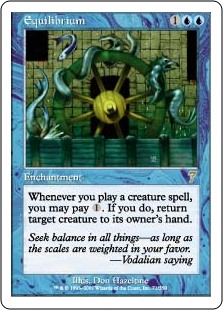
We must maintain balance
Finding cards that could work is something bound to happen throughout the deck building process, but this in many instances can yield incredibly beneficial results, every new idea adds another wrinkle to consider. Considering we’ve just spent the last few segments going through and whittling out hundreds of cards to reach the point we’re at now, the last thing we’d want to do is blindly add handfuls of new cards to the list based on ideas that seem ideal in isolation but likely won’t pan out in the long run.
To combat this, I highly advocate a One In, One Out policy. Adding more cards to a raw list is one thing, as we’ve done over the last several weeks, but since we’ve already gone through the arduous process of reaching the deck size we’re at now (with one major area left to add), the only direction you should be going is down. If we want to add creatures, artifacts, or enchantments to the mix at this junction, treat it like the middle stages of a Chess match, where players are trading and losing pieces as they move towards an endgame.
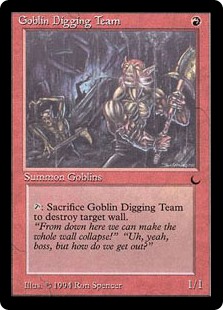
Go Team!
To this end, I’m very proud to report that my side searches and new card considerations are, relatively speaking, quite small. Having spent a lot of time doing prep work for Alesha initially, I feel like I already covered most of the conceivable angles ahead of time. But if I wasn’t continually finding new avenues to explore, I really wouldn’t be doing my job.
Additionally, I’ve also maintained from the start that I desired this to be a collaborative effort to some degree, and a few people have indeed been vocal in making suggestions, including mentioning a few cards that I overlooked.
Putting all these factors together, we have a mere 38 new cards to look at this week, lumped into four primary areas:
The Sidebored
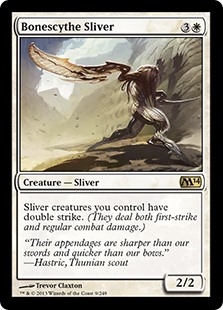
Slivers, Allies, color hate, Swamp fetch…the list goes on
Let’s touch upon each of these areas briefly, starting with the idea of +1/+1 counters. I originally went down this road because I realized at one point about a dozen or so of the 70 creatures, particularly those who are bigger than power 2 while on the battlefield, utilize counters rather than static buffs. I had coincidentally ran across Oona’s Blackguard looking something else up and the thought dawned on me that the Blackguard’s second ability could be useful if +1 counters became a subtheme.
I’ve experimented with several subtheme ideas for Alesha already, and many were cut early on. I kept these on the sideboard for a while to ponder, but I ultimately decided not to pursue this path. Even if several of those creatures make the final cut, there’s little guarantee that I’ll see many of them in the game, and it seemed way too parasitic of an idea if only a portion of the creatures will allow me to capitalize on otherwise specialized card effects.
However, this in turn led me to a pair of amazing vampires I had overlooked. I love the dichotomy of Mephidross Vampire and Necropolis Regent together, illustrating the double damnation feeling I keep fleetingly holding on to. I decided that of the two, the Necropolis Regent was too good not to be included, but that meant one of the other 13 Big Baddies needed to go. I chose one where I already have areas of redundancy:
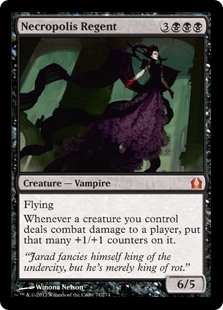
You sure you don’t want to block??
+1 Necropolis Regent -1 Boltwing Marauder
Next up was combat tricks, arguably the biggest concentration of the bunch. I started really flexing the idea of dictating combat in some manner early on as doing so likely would be highly beneficial to me. This included revisiting extra combat cards like Relentless Assault, Breath of Fury, and Aggravated Assault, several of which I had already eliminated for possible re-inclusion. This in turn also led me to consider the Bloodrush mechanic in some form (since they’re technically creatures), as well as other combat-based advantages.
In the end, few of these left a lasting impression. Bloodrush is a neat idea, but aside from Skinbrand Goblin, none are small enough to be used with Alesha. Plus, Bloodrush only works from your hand. I do, however, really like Pyrewild Shaman since it can be discarded and brought back on its own, but for the moment it hasn’t made the cut. Unlike the rest though, it (and Squealing Devil) shall remain in the sideboard pile for when we start looking at spells.
In the end, two cards were definite inclusions but were also in the Over Two Power Club, meaning others of that group had to go. The two I chose were low-hanging fruit: useful in their own ways but not essential to the deck. Surprisingly, Aurelia, the Warleader (at the moment) is not among the exchanges. Like all multiple combat situations, while Aurelia may untap creatures and grant extra combat, but any creatures Alesha brings back will not have haste unless given so by something else. This seems limiting to me, which is why Aggravated Assault didn’t make the semi-finals. I’ve left her in the sideboard for now as well, but I’m unsure of her future.
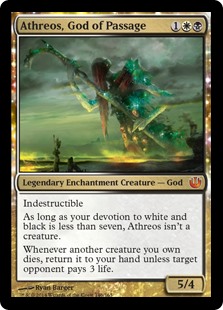
Athreos can also work against me at times. The jerk.
+ 1 Boros Battleshaper +1 Brutal Hordechief
-1 Sepulchral Primordial -1 Athreos, God of Passage
The third pile includes cards that I…just…overlooked. No other reason.
It happens. When you scan thousands of cards, you’re bound to miss a few here and there.
This pile included a couple cards that were suggested to me, as well as a few that I came across in the aforementioned searches I was doing to avoid actually working on the deck.
Of these, I considered each carefully. Deathbringer Liege is nasty when used right, but I opted out of it since there’s bound to be a fair amount of Red and / or Colorless in the deck. Similarly, I nixed Nobilis of War because its mana requirement in a tri-color deck would be far too tricky, which is sad because I suspect how well it’d work otherwise. I also sadly had to say no to Goblin Grenadiers, because as much as I like them, their use is conditional on being unblocked. I feel that between Duplicant and Necrotic Sliver I have this turf fairly well covered without that restriction.
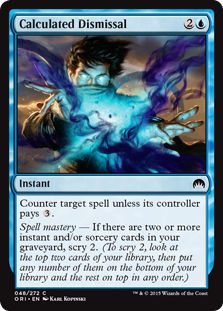
Chances are I’ll have enough hate without her anyhow
Elesh Norn I simply had to say no to because…well, I don’t have a lot of copies of her lying around, and the few I have are already in use. This is one of the hard truths about any deck building process, Commander or otherwise: sometimes you can’t include things simply because you don’t have them. This will happen, it’s completely all right. EDH isn’t about going and getting the perfect deck lists; it’s supposed to be a little more casual. I reserve the right to add Ms. Phyrexia in at a later time, however. Perhaps some day when attaining more of them becomes more affordable.
That said, this list did reveal a pair of new cards to include. Rune-Tail was a given, and frankly, I’m surprised I missed it. So long as I have the life total to flip it, I can continually bring this creature back with Alesha and attack with quasi-impunity. It made sense to replace a similar enchantment with it. The Wanderer I liked as a discard mechanic with a purpose, which I have worried at times there isn’t enough of. I cut out its opposite, oddly, but it was a card that I know was going to have a hard time making the final list, if nothing else than because I feel like a 3/2 creature is just mocking me:
+1 Rune-Tail, Kitsune Ascendant +1 Resilient Wanderer -1 Mark of Asylum -1 Grim Haruspex
The final camp includes several oddballs that I decided against for one reason or another, as well as a few we’ve seen mentioned here before. The Urborg spellshaper I like but have a hard time justifying. I know it’ll permit to discard, but it also requires tapping and I already cut its much stronger sister, Jaya Ballard, Task Mage for the same reason.
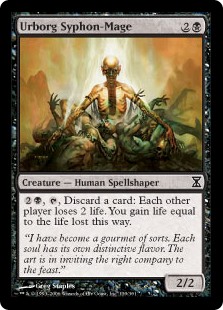
Nothing about him really says solid attacker…
So, of these, I’m strictly keeping Auramancer, Stoneforge Mystic, and Treasure Hunter in the wings until the deck gets smaller and I can see where the focus of the deck is headed. Basically, they’re to remain there until the deck starts nearing the final stages and I have the urge to start looking for more cards again to avoid finishing the job. This way I don’t complicate things by doing precisely that.
And there you have it. For all of the new cards that we introduced, a handful made it into the deck list and a few will be kept to the side for now. Mostly though, we weren’t able to unseat what is shaping up to be a fairly solid deck.
This is but a respite between the action, of course, as we have one more major component to add to the deck: spells. Next time, we’ll be addressing those, while also taking the opportunity to start cutting down our selection in earnest. It won’t be easy, but it has to be done. Just be careful, as flailing about may be part of that process.
Alesha's Season Two Semi Finalists
